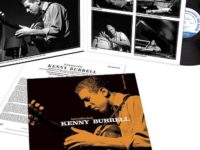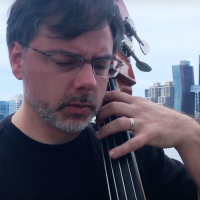Finally, a musician with a one-letter last name I can actually embrace.
Harvie S was the rock-solid bassist who firmly anchored Linda Presgrave’s completely enjoyable Inspiration CD, released last month. It’s only the latest notch in a long career that’s found S paired with such legends as John Scofield, Stan Getz, Chet Baker, Dexter Gordon, Jim Hall, Michael Brecker, Gil Evans, Pat Metheny, Art Farmer, Toots Thielemans, Tommy Flanagan, Joe Lovano, Yusef Lateef, Danilo Perez, Paquito D’Rivera, Mark Turner and Sheila Jordan.
Back in 1986, S—then known as Swartz—got some bonus studio time and invited another legend, Kenny Barron, to come in and perform some piano/bass duets with him. Since the original intent wasn’t to make a record, the two played without any real rehearsal and strictly for themselves, using merely a two-track recorder. They performed all jazz standards (except for the excellent blues-based S original “Take Your Time”), with arrangements that capitalized on the duo format, a format that was popular with the New York jazz scene at that time.
The two together is symbiotic magic, with neither taking a predominant role for so long that you forget about the interesting melody itself. Instead, they often take on complementary roles that blur the line between improvisation and carrying the tune. Harvie S’s bass style is old school in that it derives much from Oscar Pettiford and Ray Brown, and is sweetly toned with no woodiness or rough edges. He shows a strong predilection for playing the right notes, not the most difficult ones, which makes it easy to listen to him all day. Kenny Barron is, well, Kenny Barron: the master accompanist and a soloist of the highest order.
Besides the Harvie S original, I especially enjoyed their take on Wayne Shorter’s “Miyako,” the perky rendering of “All Or Nothing At All,” and the heartfelt performance of “Body And Soul.” And S playing so lyrically in the upper register for “Darn That Dream” is not such a bad treat for the ears, either.
A cassette of this twenty-three year old session was found by Harvie after being forgotten all these years. A better copy of it was found and miraculously restored to a high quality despite that lack of the master tape, and finally released to CD last August. If there are any doubts that a piano and acoustic bass alone can make full, rich beautiful music together, Now Was The Time will forcefully dispel any such skepticism.
Don’t let that truncated last name fool you; the “S” means “superb” when it comes to jazz stand-up bass playing.
- Christian Marien Quartett – ‘How Long Is Now’ (2024) - April 18, 2024
- Dave Douglas, feat. James Brandon Lewis – ‘Gifts’ (2024) - April 11, 2024
- Thollem – ‘Worlds In A Life, Two’ (2024) - April 8, 2024




